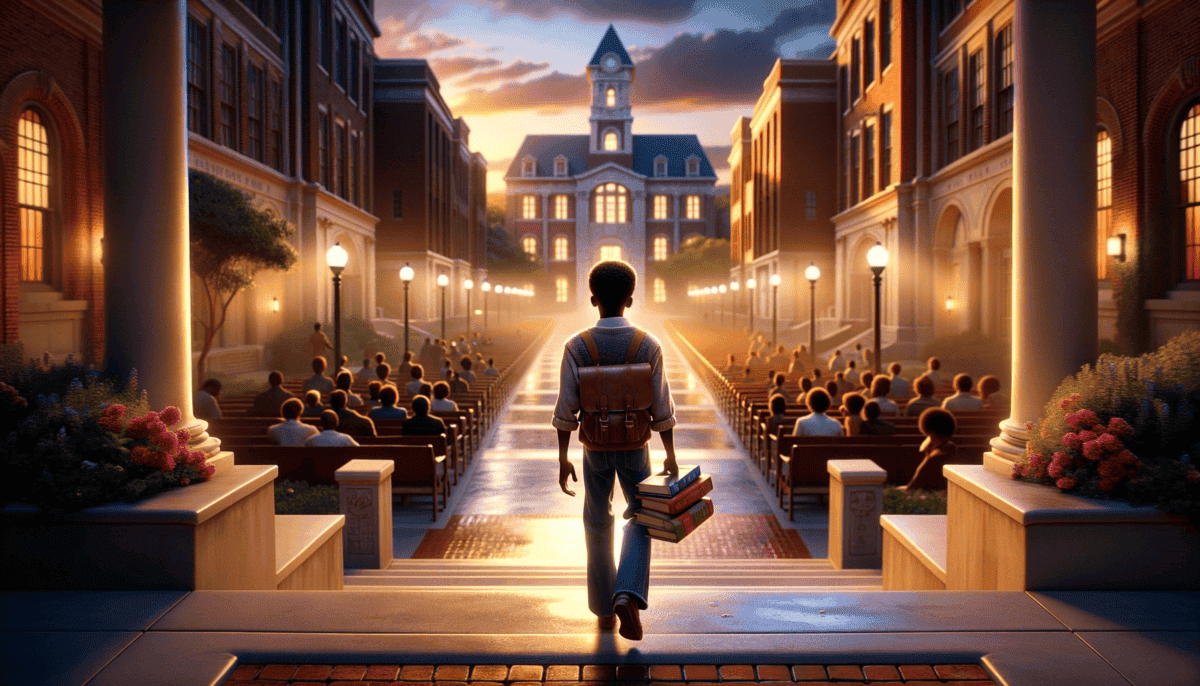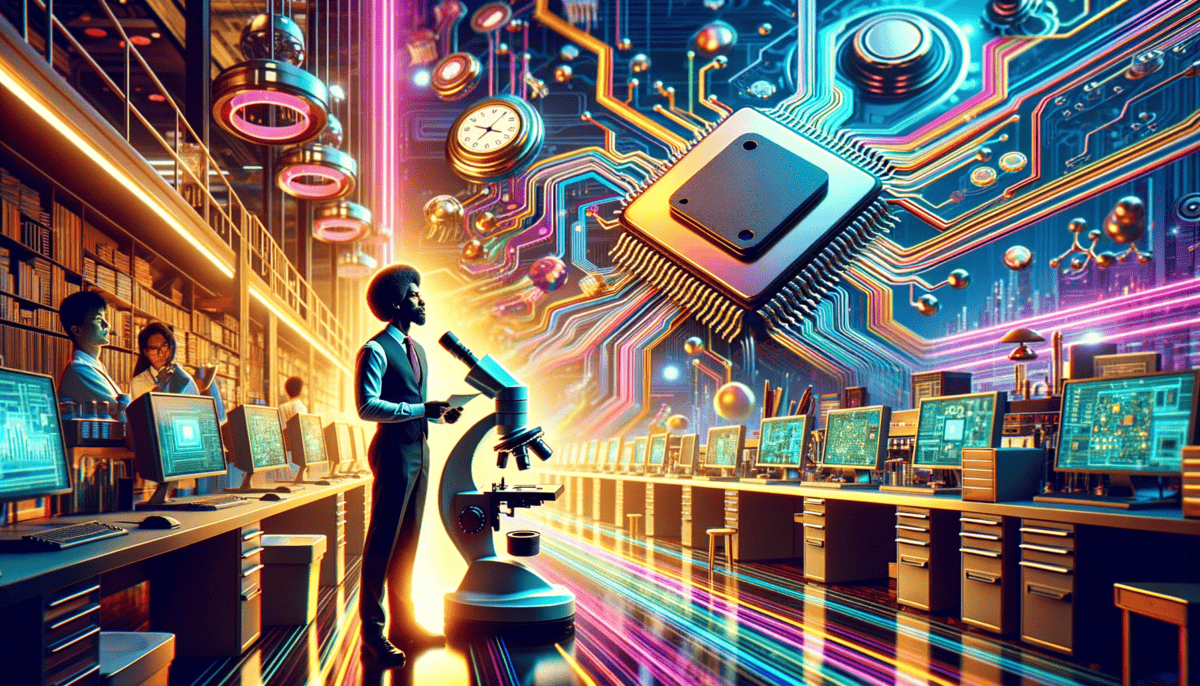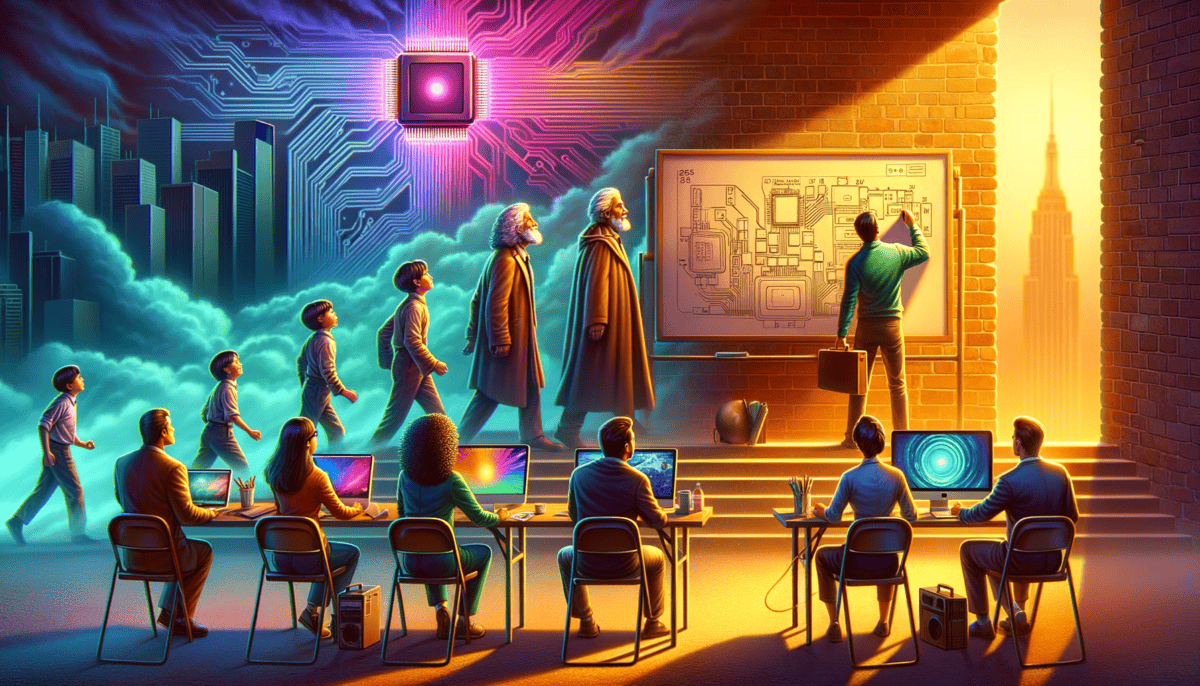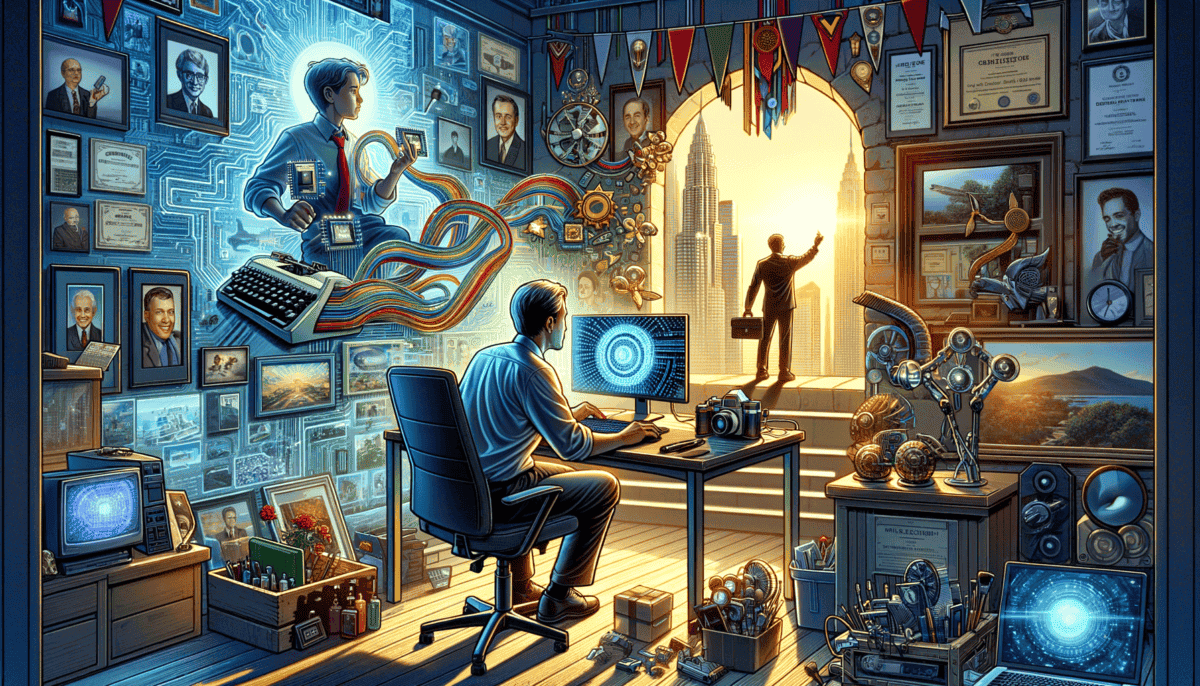A Young Inventor’s Dream
Little Mark Dean sat on his front porch in Jefferson City, Tennessee. The warm summer breeze carried the sweet smell of honeysuckle as he carefully took apart his mother's broken calculator. His small fingers worked with care, just like his father had taught him.
"What are you up to there, Mark?" his father asked, stepping onto the porch.
"I want to see how it works inside," Mark replied, his eyes sparkling with curiosity. "Maybe I can fix it!"
It was 1961, and six-year-old Mark was already showing signs of becoming something special. While other kids played with toy cars, Mark preferred to take them apart and put them back together.
At school, Mark's teacher noticed his special talent for math and science. "Mark," she said one day, "you have a gift for understanding how things work."
Mark loved spending time in his father's workshop. The walls were lined with shiny tools, and the air smelled like metal and wood. His father taught him how to use each tool safely.
"Remember son," his father would say, "anything broken can be fixed if you understand how it works."
Dreams Take Flight
One day, Mark found an old radio in the workshop. Instead of music, it made strange crackling sounds.
"Can I try to fix it, Dad?" Mark asked excitedly.
His father nodded and smiled. "Just be careful and take your time."
Mark spent hours studying the wires and parts inside. He cleaned connections and adjusted tiny pieces until finally…music filled the room! His parents couldn't believe their ears.
"You did it!" his mother exclaimed, giving him a big hug.
That moment changed everything for young Mark. He knew then that he wanted to spend his life making things work better.
Building Dreams
Every day after school, Mark would:
- Read books about machines
- Practice math problems
- Take apart old devices
- Draw pictures of new inventions
- Help his father fix things
His teachers started giving him special projects. They saw something amazing in the quiet boy who could make broken things work again.
“I knew from an early age that I wanted to be an inventor,” Mark would later say. “I just didn’t know how far it would take me.”
The neighborhood kids started bringing Mark their broken toys. They called him "The Fix-It Kid." Mark didn't mind – each broken toy was a new puzzle to solve.
One evening, as Mark worked on yet another project, his mother placed a magazine on his desk. The cover showed a big computer.
"What's this?" Mark asked, looking at the strange machine.
"The future," his mother replied with a smile. "And I think you're going to be part of it."
Mark stared at the picture for a long time. Computers were rare in Tennessee in those days. But something about that machine spoke to him. It was like all the pieces of his life – the fixing, the building, the dreaming – suddenly fit together.
That night, as crickets chirped outside his window, Mark made a promise to himself. He would learn everything he could about these amazing machines. He would make them better, faster, and more helpful for everyone.
Little did young Mark know, but that promise would one day change the world of computers forever. His journey from fixing calculators to inventing computer parts was just beginning, and what a journey it would be!
Dreams and Determination
The halls of the University of Tennessee buzzed with excitement. It was 1975, and Mark Dean walked through them with purpose. His backpack was heavy with engineering books.
“Hey Mark!” called his classmate Tom. “Ready for the big test?”
“You know it,” Mark smiled, though his heart beat faster. Being one of the few Black students in engineering wasn’t easy.
Challenge Accepted
Mark sat in the front row of his electronics class. His professor drew complex circuits on the board. Some students looked confused, but Mark’s eyes lit up. This was just like fixing radios with his dad, only bigger!
“This circuit design is impossible,” groaned a student behind him.
“Nothing’s impossible,” Mark whispered to himself, remembering his father’s words. “Just needs the right solution.”
Late at night, Mark studied in the library. While others went to parties, he solved extra problems. He drew circuit designs in his notebook until his hand cramped.
“Some nights were so hard I wanted to quit. But then I’d remember why I started – to make things that help people.”
Big Dreams at IBM
One spring day, a man in a suit visited the engineering department. He was from IBM, a big computer company. ️
“We’re looking for bright minds,” he announced. “People who can help us build the future.”
Mark’s hand shot up first when they asked for questions. His ideas impressed everyone in the room.
Making History
The things that helped Mark succeed were:
- Working extra hard
- Never giving up
- Asking good questions
- Being creative
- Believing in himself
On graduation day, Mark’s family beamed with pride. His father hugged him tight.
“Remember when you fixed that old calculator?” his mother asked, tears in her eyes.
“Now I’m going to help build computers!” Mark grinned.
His first day at IBM felt like a dream. The building was huge, full of the newest computers. But some people didn’t think a young Black engineer could do the job.
“Watch me,” Mark thought, rolling up his sleeves. He worked twice as hard to prove them wrong.
Each morning, Mark arrived early to work on his ideas. He thought about ways to make computers faster and better. His co-workers started noticing his talent.
“How do you come up with these ideas?” they would ask.
Mark would smile and say, “I just see problems as puzzles waiting to be solved.”
His first project was improving computer chips. It reminded him of fixing that old radio – just much, much smaller! His hands were steady, his mind sharp.
Every success made Mark think of that little boy on the porch in Tennessee. That boy who believed he could fix anything. Now he was fixing and improving things that would help millions of people.
The other engineers started coming to Mark with their toughest problems. They knew he would find a way to solve them. Just like when neighborhood kids brought him their broken toys, but now he was fixing the future.
As the sun set over IBM’s buildings, Mark would often stay late, drawing new designs. He wasn’t just working – he was changing the world, one computer chip at a time.
Racing to a Billion
Mark Dean sat at his desk at IBM, staring at a tiny computer chip. His coffee was cold, forgotten hours ago.
“It’s still not fast enough,” he mumbled, tapping his pencil on the desk.
The Big Problem
“What’s bothering you, Mark?” asked Sarah, his lab partner.
“These chips,” Mark sighed. “They’re like cars stuck in traffic. We need to build a bigger highway for the information to travel on.”
Every computer chip had a speed limit. The fastest ones could only do a few hundred million things per second. Mark knew computers needed to go faster.
The Light Bulb Moment
One night, while watching his son play with toy cars, Mark had an idea.
“What if we don’t just make one road bigger,” he thought out loud, “but build many roads side by side?”
Back at IBM, Mark drew his new design. His hands shook with excitement.
“This could work,” Sarah said, looking over his shoulder. “But nobody’s ever done it before.”
“That’s exactly why we should try,” Mark smiled.
Building the Future
Mark and his team worked day and night. They faced many problems:
- The chip got too hot
- Some paths didn’t line up right
- Many people said it wouldn’t work
- The machines needed new programming
- Each test cost lots of money
But Mark didn’t give up. He remembered his father saying, “The harder the problem, the sweeter the solution.”
“Sometimes you have to ignore the people who say something can’t be done. They might just lack imagination.”
The Big Test
After months of work, the day came to test the new chip. The lab was silent. Everyone held their breath.
“Ready?” Mark asked, his finger over the power button.
“Ready!” the team answered.
The computer hummed to life. Numbers flashed on the screen. Sarah checked the speed meter.
“Mark!” she shouted. “It’s working! We did it – one gigahertz!”
The room erupted in cheers. People hugged and high-fived. Mark just stood there, grinning.
“Now computers can think faster than ever,” he said. “Just imagine what they’ll be able to do!”
That night, Mark called his father.
“Dad, remember how you taught me to fix that old radio?”
“Sure do, son.”
“Well, today I fixed something much bigger. I helped make computers faster than anyone thought possible.”
His father chuckled. “I always knew you would do amazing things, Mark. You never saw problems – only possibilities.”
Mark looked out his office window at the setting sun. The gigahertz chip was just the beginning. He had more ideas, more dreams to chase.
Tomorrow, he would start working on his next big idea. But tonight, he would celebrate this victory – a victory that would help change the world of computers forever.
Building Digital Bridges
The sun was just rising over IBM’s research lab. Mark Dean walked through the quiet halls, carrying a box of broken computer parts.
A Messy Desk
“Look at all these different plugs,” Mark said, dumping the parts on his desk. “Every printer needs a special connection. Every monitor needs its own wire. It’s like having different keys for every door in your house!”
His colleague Tom walked in, carrying coffee. “Still trying to solve the connector problem?”
“These machines need to talk to each other better,” Mark replied, picking up a printer cable. “We need one way to connect everything.”
The Big Dream
“Imagine if you could plug any device into any computer, and it just worked – like magic!”
Mark grabbed his notebook and started drawing. His pencil flew across the paper as he sketched a new kind of connector.
“What if we made a special highway just for computer parts to talk to each other?” he wondered aloud. ️
Building the Bus
Mark called his idea the Industry Standard Architecture (ISA) bus. But he explained it to people in a simpler way:
“It’s like building a special road where all computer parts can drive on, no matter what kind they are!”
Testing Time
The team worked hard to build the first ISA system. They tested it with:
- Different printers
- Many types of monitors
- Keyboards from other companies
- New and old computer parts
- Various storage devices
One day, Sarah from the testing lab burst into Mark’s office.
“Mark! Come quick! It’s working with EVERYTHING!”
A New World
The ISA bus changed everything. Now people could:
“Just plug in their printer and start printing!” ️
“Connect any monitor and see their work!” ️
“Add new parts without buying a new computer!”
Sharing the News
At the next company meeting, Mark showed everyone his invention.
“Before, computers were like islands,” he explained. “Now they’re like cities connected by bridges!”
That evening, Mark sat in his office, watching people try the new system. A young intern plugged in a printer, and it worked instantly. Her face lit up with surprise and joy.
“That’s why we do this,” Mark thought, smiling. “To make technology work for people, not the other way around.”
He picked up a new monitor from his desk. It was time to tackle his next challenge – bringing color to computer screens. But that would be another adventure.
A Rainbow Revolution
Mark Dean stared at the dull, green-glowing monitor on his desk. The black screen with green letters looked like something from an old spaceship movie. ️
The Color Dream
“What if computers could show all the colors of the rainbow?” Mark wondered out loud. He grabbed his favorite red marker and started drawing.
His friend Lisa walked by his desk. “Still thinking about colorful screens?”
“Kids should see their drawings in real colors,” Mark said. “Not just green!”
Making Colors Dance
“Every pixel needs to dance with red, blue, and green light – just like mixing paints!”
Mark grabbed three flashlights and some colored paper. He showed his team how colors mix:
- Red + Blue = Purple
- Blue + Yellow = Green
- Red + Yellow = Orange
- All Colors = White
- No Colors = Black
Building the Rainbow
The team worked day and night. They had to solve many puzzles:
“How do we make the reds bright enough?”
“Can we make the greens look natural?”
“Will the blues be clear?”
Test Time
One morning, Mark called everyone to the lab. “Ready to see something amazing?”
He turned on the new monitor. The screen burst into life with bright, beautiful colors!
“It’s like a rainbow!” someone shouted.
“No,” Mark smiled. “It’s better than a rainbow. These colors can make pictures move!”
Sharing the Colors
The color monitor changed everything about computers:
Artists could draw in real colors!
Kids could play colorful games!
Workers could see charts better!
A Colorful Future
Mark watched as people gathered around the new color screen. Their faces glowed with excitement.
That evening, Mark sat in his quiet office. He turned on his new color monitor and opened a drawing program. With a smile, he started drawing a bright, yellow sun.
“Now,” he thought, “computers can show the world in all its beautiful colors.”
But Mark knew his work wasn’t done. There were still more ways to make computers better for everyone. His next big idea was already forming in his mind.
The Future Shines Bright
Today, Mark Dean walks through a modern computer store. Bright screens shine everywhere. Each one shows perfect colors, just like he dreamed about years ago.
Looking Back
“Remember your first computer?” a young student asks Mark during a school visit.
Mark smiles. “It could only show green letters on a black screen. No colors, no pictures, no fun!”
The students gasp. One raises her hand. “But how did you know how to make it better?”
“I dreamed big,” Mark says. “And I never gave up.”
Mark’s Special Awards
People noticed Mark’s hard work. He won many special prizes:
- Member of the National Academy of Engineers
- IBM Fellow (A very special title!)
- Distinguished Engineer Award ⭐
- Black Engineer of the Year
- Inventor of the Year
Teaching New Dreamers
“Dream big, work hard, and never let anyone tell you something is impossible!”
Mark visits schools to talk to kids. He tells them:
“You can be an inventor too!”
“Science is for everyone!”
“Keep asking questions!” ❓
The Big Picture
Fast computer chips, color screens, and ways to connect printers and other things to computers! ️
What’s Next?
Mark still dreams about new ideas. He thinks about:
Computers that can help doctors more ⚕️
Screens that fold like paper
Ways to make computers use less power ⚡
A Message for You
Mark looks at a classroom full of excited kids. They all hold tablets with bright, colorful screens.
“Remember,” he says with a warm smile, “every big idea starts with a simple dream. What’s your dream?”
As the sun sets outside his window, Mark thinks about all the young inventors who will come next. He knows they will make things even better than he did. The future is as bright as the screens he helped create.
“The best inventions,” he whispers, “are the ones that help everyone.”






